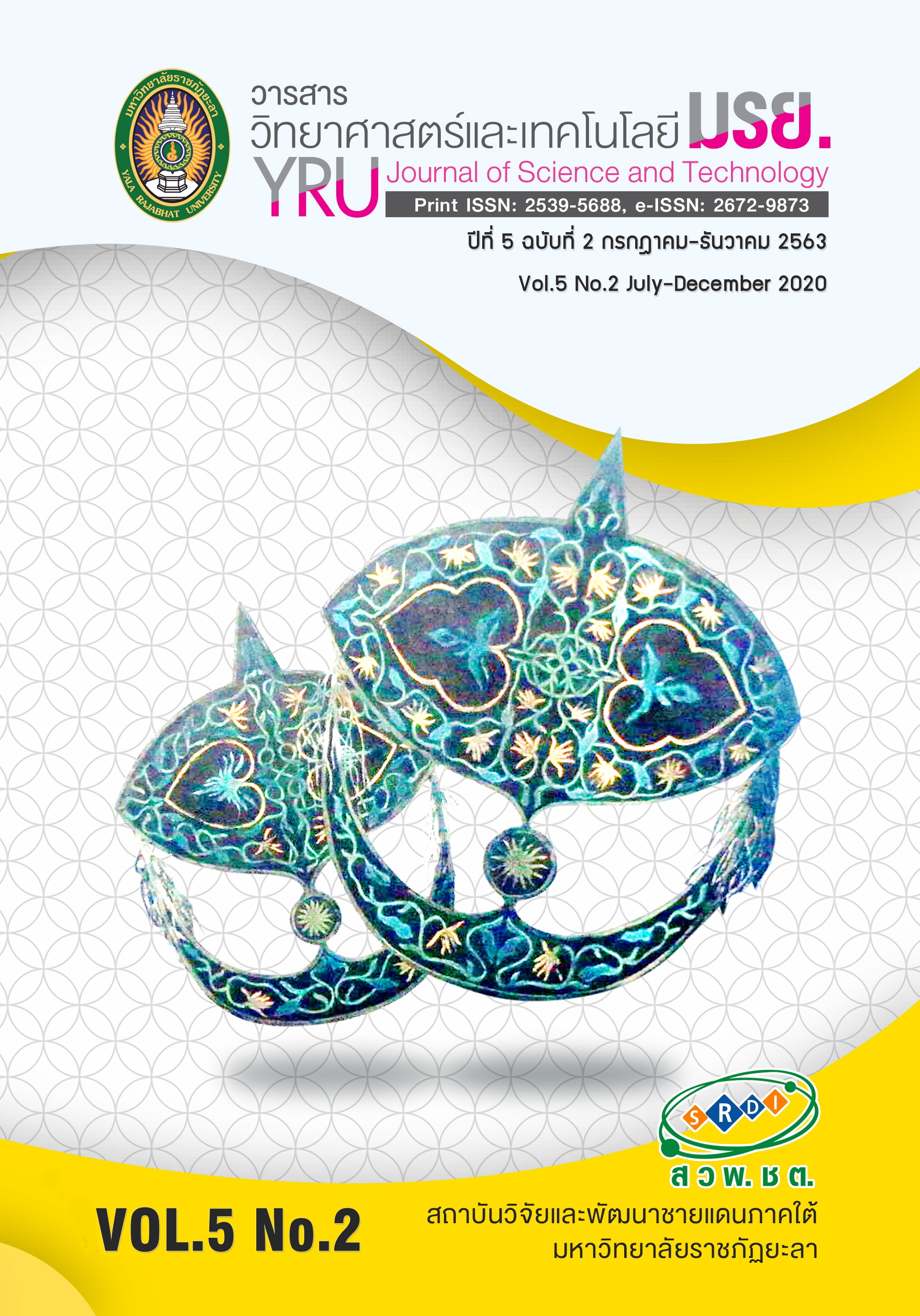การจำลองการจับเชิงโมเลกุลของสารที่มีฤทธิ์ยับยั้งทูเมอร์นิโครซิสแฟคเตอร์แอลฟาจากเมล็ดกัญชง
Main Article Content
บทคัดย่อ
ทูเมอร์นิโครซิสแฟคเตอร์แอลฟาเป็นโปรไซโตไคน์ที่สำคัญต่อการก่อให้เกิดการอักเสบ ไซโตไคน์นี้จึงเป็นเป้าหมายใหม่สำหรับ
การรักษาและป้องกันโรคทางระบบภูมิคุ้มกันที่เกี่ยวกับการอักเสบ การศึกษาก่อนหน้านี้ได้รายงานถึงศักยภาพของสารกลุ่ม Phenolamides ในเมล็ดกัญชงว่ามีฤทธิ์ต้านการอักเสบ อย่างไรก็ตามกลไกต้านการอักเสบของสารกลุ่ม Phenolamides
ยังไม่ชัดเจน ในการศึกษานี้ใช้เทคนิคการจำลองการจับเชิงโมเลกุลสำหรับทดสอบอันตรกิริยาระหว่างสารกลุ่ม Phenolamides จำนวน 5 ชนิด กับโมเลกุลทูเมอร์นิโครซิสแฟคเตอร์แอลฟา ผล พบว่าสารCoumaroylaminobutanol glucopyranoside มีศักยะในการยับยั้งทูเมอร์นิโครซิสแฟคเตอร์แอลฟามากที่สุด การศึกษานี้ทำให้เข้าใจฤทธิ์ต้านการอักเสบของเมล็ดกัญชงมากขึ้น
Article Details
บทความ ข้อมูล เนื้อหา รูปภาพ ฯลฯ ที่ได้รับการเผยแพร่ในวารสารวิทยาศาสตร์และเทคโนโลยี มรย. นี้ ถือเป็นลิขสิทธิ์ของวารสารวิทยาศาสตร์และเทคโนโลยี มรย. หากบุคคลหรือหน่วยงานใดต้องการนำทั้งหมดหรือส่วนหนึ่งส่วนใดไปเผยแพร่ต่อหรือกระทำการใดๆ จะต้องได้รับอนุญาตเป็นลายลักษณ์อักษรจากวารสารวิทยาศาสตร์และเทคโนโลยี มรย. ก่อนเท่านั้น
เอกสารอ้างอิง
Awortwe, C., Bruckmueller, H., & Cascorbi, I. (2019). Interaction of herbal products with prescribed medications: A systematic review and meta-analysis. Pharmacological research, 141, 397–408.
Crescente, G., Piccolella, S., Esposito, A., Scognamiglio, M., Fiorentino, A., & Pacifico, S. (2018). Chemical composition and nutraceutical properties of hempseed: an ancient food with actual functional value. Phytochemistry Reviews, 17(4), 733-749.
Daina, A., Michielin, O., & Zoete, V. (2017). SwissADME: a free web tool to evaluate pharmacokinetics, drug-likeness and medicinal chemistry friendliness of small molecules. Scientific Reports, 7, 42717.
English, B. A., Dortch, M., Ereshefsky, L., & Jhee, S. (2012). Clinically significant psychotropic drug-drug interactions in the primary care setting. Current Psychiatry Reports, 14(4), 376-390.
Guengerich, F. P., Waterman, M. R., & Egli, M. (2016). Recent Structural Insights into Cytochrome P450 Function. Trends in Pharmacological Sciences, 37(8), 625-640.
Mitoma, H., Horiuchi, T., Tsukamoto, H., & Ueda, N. (2018). Molecular mechanisms of action of anti-TNF-α agents - Comparison among therapeutic TNF-α antagonists. Cytokine, 101, 56–63.
Naim, M. J., Alam, O., Alam, M. J., Hassan, M. Q., Siddiqui, N., Naidu, V., & Alam, M. I. (2018). Design, synthesis and molecular docking of thiazolidinedione based benzene sulphonamide derivatives containing pyrazole core as potential anti-diabetic agents. Bioorganic chemistry, 76, 98–112.
Pagadala, N. S., Syed, K., & Tuszynski, J. (2017). Software for molecular docking: a review. Biophysical Reviews, 9(2), 91-102.
Pettersen, E. F., Goddard, T. D., Huang, C. C., Couch, G. S., Greenblatt, D. M., Meng, E. C., & Ferrin, T. E. (2004). UCSF Chimera--a visualization system for exploratory research and analysis. Journal of Computational Chemistry, 25(13),1605-1612.
Poulsen, M. M., Fjeldborg, K., Ornstrup, M. J., Kjær, T. N., Nøhr, M. K., & Pedersen, S. B. (2015). Resveratrol and inflammation: Challenges in translating pre-clinical findings to improved patient outcomes. Biochimica et Biophysica Acta, 1852(6), 1124–1136.
Razzaghi-Asl, N., Sepehri, S., Ebadi, A., Miri, R., & Shahabipour, S. (2015). Effect of Biomolecular Conformation on Docking Simulation: A Case Study on a Potent HIV-1 Protease Inhibitor. Iranian journal of pharmaceutical research, 14(3), 785–802.
Trott, O., & Olson, A. J. (2010). AutoDock Vina: improving the speed and accuracy of docking with a new scoring function, efficient optimization, and multithreading. Journal of Computational Chemistry, 31(2), 455-461.
Wang, Q., He, J., Wu, D., Wang, J., Yan, J., & Li, H. (2015). Interaction of α-cyperone with human serum albumin: Determination of the binding site by using Discovery Studio and via spectroscopic methods. Journal of Luminescence, 164, 81-85.
Wu, J., Qu, Y., Deng, J., Liang, W., Jiang, Z., Lai, R., & Yu, Q. (2016). Resveratrol inhibition of TNF-α and IL-1 for treatment of rheumatoid arthritis: from In-Silico to In-vitro elucidation. International Journal of Clinical and Experimental Medicine, 9(2), 745-752.
Zhou, Y., Wang, S., Lou, H., & Fan, P. (2018). Chemical constituents of hemp (Cannabis sativa L.) seed with potential anti-neuroinflammatory activity. Phytochemistry Letters, 23, 57-61


